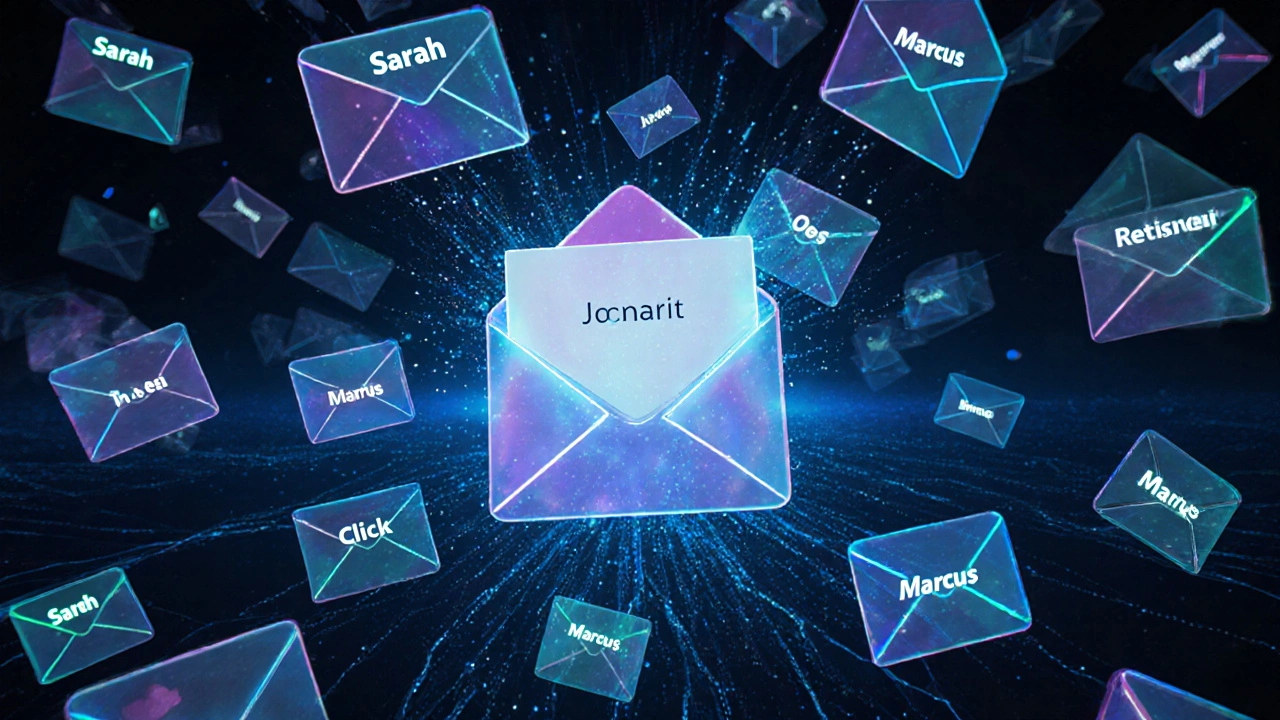Ad Copy Generator with ChatGPT
Create High-Converting Ad Copy in Seconds
Based on the article "How ChatGPT Boosts Your Digital Marketing Results Today", this tool generates multiple ad variations using proven prompt strategies that can increase your click-through rates by up to 40%.
Your Generated Ad Variations
Most digital marketers are still writing emails, social posts, and ad copy by hand. That’s not just slow-it’s expensive. By the time you finish drafting five versions of a product description, a competitor using ChatGPT has already tested 50 variations, analyzed which one converts best, and rolled it out across their entire campaign. This isn’t science fiction. It’s happening right now, and the gap between those who use AI and those who don’t is growing fast.
ChatGPT cuts content creation time in half
Creating consistent, high-quality content is the biggest bottleneck in digital marketing. You need blog posts, email sequences, landing pages, ad headlines, product descriptions, and social captions-all on schedule, every week. Doing this manually means long hours, burnout, and inconsistent quality.
ChatGPT changes that. Type in a simple prompt like “Write a 300-word blog post about sustainable packaging for eco-friendly skincare brands, in a friendly but professional tone,” and you get a solid draft in under 30 seconds. You don’t have to accept it as-is. Edit it. Add your brand voice. Insert real customer quotes. But now you’re starting with a working draft, not a blank page.
A 2024 survey of 1,200 U.S.-based marketers found that teams using ChatGPT for content creation reduced their average content production time from 8 hours per piece to just 3.7 hours. That’s a 54% drop. That time saved isn’t just about efficiency-it’s about scale. You can now test more ideas, launch more campaigns, and respond faster to trends.
Personalization at scale, without hiring more staff
Customers expect messages that feel made for them. But personalizing emails or ads for thousands of people? That used to mean expensive CRM tools, data scientists, and manual segmentation. Now, ChatGPT does it with simple prompts.
Instead of sending the same “Winter Sale” email to everyone, you can generate 100 different versions based on past behavior. “Hi Sarah, since you bought the lavender body oil last month, here’s a new scent you might love…” or “Hi Marcus, you left items in your cart-here’s 15% off to complete your order.”
Tools like Klaviyo and HubSpot now integrate directly with ChatGPT. You feed in customer data-purchase history, browsing behavior, location-and the AI writes hyper-personalized copy in seconds. One e-commerce brand in Ohio saw a 32% increase in open rates and a 21% jump in conversions after switching to AI-generated personalized emails. No A/B testing needed. The AI figured out what worked before they even sent it.
Chatbots that actually sound human
Most chatbots feel robotic. They answer with canned responses. They get stuck. They frustrate customers. That’s because they’re built on rigid decision trees, not real language understanding.
ChatGPT-powered chatbots are different. They don’t just match keywords-they understand context. If a customer says, “I ordered the blue shirt but it’s too tight,” the bot doesn’t just reply with “Returns are here.” It says, “Sorry to hear that! The blue shirt runs small. Would you like to exchange it for the next size up, or should I send you a return label for a full refund?”
Companies like Sephora and Nordstrom use AI chatbots to handle 60% of customer service inquiries without human intervention. That cuts support costs and keeps customers happy. And it works 24/7. No shifts. No overtime. No missed messages at midnight.

SEO content that ranks-and keeps ranking
SEO isn’t just about keywords anymore. Google’s algorithms now reward content that feels natural, answers questions deeply, and keeps readers engaged. ChatGPT helps you do all three.
Use it to generate topic clusters. Ask: “What are the top 10 questions people ask about organic skincare?” Then turn each answer into a blog post. Use it to rewrite outdated pages. Plug in your old 2022 article about “best email subject lines” and ask: “Update this for 2025 with current best practices and real examples.”
One SEO agency in Atlanta used ChatGPT to overhaul 87 blog posts. They didn’t just rewrite them-they added fresh data, real case studies, and updated statistics. Within three months, organic traffic to those pages increased by 140%. The content didn’t just rank better-it became a lead magnet.
Ad copy that converts better, every time
Facebook and Google ads live or die by their headlines and descriptions. One word change can make the difference between a click and a scroll-past.
ChatGPT can generate dozens of ad variations in minutes. Try this prompt: “Generate 15 Facebook ad headlines for a meal prep service targeting busy moms aged 30-45. Focus on saving time, reducing stress, and healthy eating. Use emojis sparingly.”
Then test them. Run three versions simultaneously. Let the data tell you which one performs best. ChatGPT doesn’t guess. It gives you options. You choose the winner. That’s how top-performing ad accounts work-constant testing, zero guesswork.
A small fitness brand in Texas used this method to boost their ad click-through rate from 1.8% to 4.2% in two weeks. Their cost per lead dropped by 47%.

Competitor insights without spying
What are your competitors writing? What messaging are they using? Where are they failing?
You don’t need to hire a spy. Just feed ChatGPT a few of their blog posts, product pages, or social captions and ask: “Analyze these three pieces of content. What tone do they use? What pain points do they address? What’s missing?”
It’ll tell you if they’re overusing “affordable,” ignoring customer emotions, or skipping FAQs. Then you can write content that’s sharper, deeper, and more human. That’s how you win-not by copying, but by outthinking.
Real risks-and how to avoid them
ChatGPT isn’t magic. It makes mistakes. It sounds generic if you don’t guide it. It can hallucinate facts. That’s why you still need humans.
Never publish AI content without editing. Always fact-check. Add your brand’s personality. Inject real stories. Use your own voice. Don’t let ChatGPT replace you-let it amplify you.
Also, don’t use it for legal disclaimers, medical advice, or financial guidance unless you’re a licensed expert. AI doesn’t understand liability. It only predicts words.
The best marketers aren’t the ones using AI the most. They’re the ones using it the smartest.
Where to start today
Don’t try to automate everything at once. Pick one area. Start small.
- Take your next email campaign. Use ChatGPT to write the subject line and first paragraph.
- Generate five variations of your most popular blog post’s intro.
- Ask it to rewrite your top-performing Facebook ad with a different tone.
- Use it to draft responses to your top five most common customer questions.
Track the results. Compare performance. See what works. Then do it again. In six weeks, you’ll wonder how you ever worked without it.
Can ChatGPT replace my marketing team?
No. ChatGPT is a tool, not a replacement. It handles repetitive tasks like drafting, brainstorming, and editing-but it can’t build strategy, understand brand nuance, or connect emotionally with customers the way a human can. The best outcomes happen when marketers use ChatGPT to do the heavy lifting, then step in to add soul, authenticity, and direction.
Is ChatGPT free to use for marketing?
You can use the free version of ChatGPT for basic tasks like drafting emails or generating ideas. But for serious marketing work-especially if you’re scaling content or integrating with tools like CRM systems-you’ll need ChatGPT Plus ($20/month). It gives you faster responses, access to GPT-4, and the ability to upload files for analysis, which is essential for reviewing past campaigns or competitor content.
Does using AI hurt SEO rankings?
No, not if you use it right. Google doesn’t penalize content just because it was written with AI. What matters is quality, originality, and usefulness. If your AI-generated content is thin, repetitive, or full of errors, it’ll rank poorly. But if you edit it, add real insights, personalize it, and make it genuinely helpful, Google rewards it-just like any other high-quality content.
How do I make ChatGPT sound like my brand?
Give it examples. Paste three of your best blog posts or social captions into ChatGPT and say, “Write in this tone.” Or create a brand style guide: “We use short sentences. We avoid jargon. We sound friendly but not casual. We mention real customer experiences.” Then paste that guide into every prompt. The more you train it with your own voice, the better it gets at mimicking it.
What’s the biggest mistake marketers make with ChatGPT?
The biggest mistake is treating it like a magic button. Copying and pasting AI output without editing leads to bland, generic content that doesn’t stand out. The real power comes from using it as a co-pilot-starting with AI, then refining with your expertise, experience, and brand voice. The best marketers don’t use AI to replace thinking. They use it to think faster.
If you’re not using ChatGPT in your marketing right now, you’re not falling behind-you’re already behind. The tools are here. The data proves it works. The question isn’t whether you should use it. It’s how soon you’ll start.


As a passionate marketer, I strive to connect businesses with their target audiences in creative ways. I specialize in developing and implementing digital and content marketing strategies. I am currently working as a Marketing Manager at a renowned firm. In my spare time, I love to share my knowledge about online marketing through my blog. I believe that continuous learning and sharing of knowledge are keys to growth.